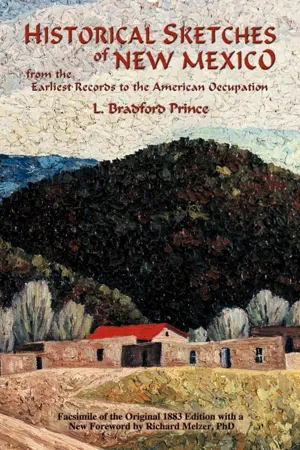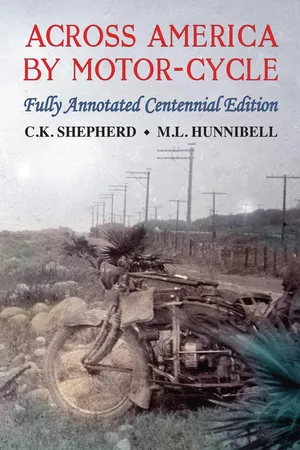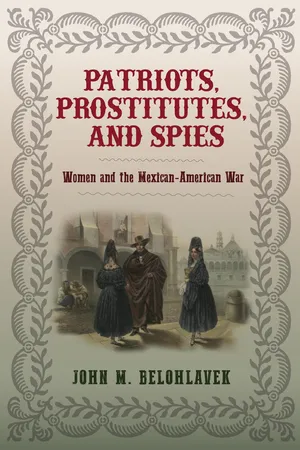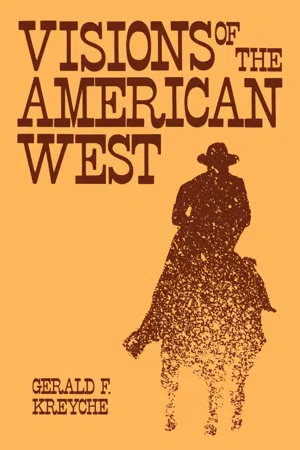History
Santa Fe Trail
The Santa Fe Trail was a 19th-century transportation route that connected Missouri to Santa Fe, New Mexico. It was used primarily for trade and commerce, and played a significant role in the expansion of the United States into the Southwest. The trail was in operation from 1821 to 1880.
Written by Perlego with AI-assistance
Related key terms
Related key terms
1 of 4
Related key terms
1 of 3
6 Key excerpts on "Santa Fe Trail"
- eBook - ePub
Historical Sketches of New Mexico
From the Earliest Records to the American Occupation
- L. Bradford Prince, Lebaron Bradford Prince(Authors)
- 2009(Publication Date)
- Sunstone Press(Publisher)
CHAPTER XVIII. THE SANTA FÉ TRAIL.T HOUGH Mexico was settled early in the sixteenth century, and the Spaniards soon after penetrated over 1,500 miles to the north and occupied the valley of the Rio Grande as far as Taos and the Chama in northern New Mexico, and another colonization from England and France had populated the eastern shores of what is now the United States and Canada early in the seventeenth century, and had extended westward to the Mississippi Valley, and was constantly pushing on further into the wilderness and advancing the pioneer line of its civilization toward the setting sun; yet strangely enough, it was left for the nineteenth century, in which we live, to see any communication whatever between these two populations, situated on the same continent, yet separated by mountains and rivers and by the great expanse of what was then believed to be desert plain.The French and Spaniards had successively been the rulers of the vast territory extending westward from the Mississippi to the limits of Mexico and the shores of the Pacific, and then all included under the name of Louisiana ; yet the people of neither of those nationalities had displayed the enterprise or spirit of adventure requisite for an attempt to cross the intervening space be ween themselves and New Mexico, and brave the hostility of the tribes which roamed over the plains between.It was not until after the acquisition of Louisiana by the United States that such a journey was accomplished, or even attempted. In 1803 President Jefferson completed the negotiation for the purchase of Louisiana from the Emperor Napoleon, and the sovereignty of that vast domain was transferred from the French to the Americans. The chief city of the Mississippi Valley, in the newly acquired territory,was St. Louis ; the principal settlement on the easterly side of the river, within the old boundaries of the United States, was Kaskaskia. Each of these places claims the credit of sending the first adventurers across the plains to meet the tide of Spanish colonization coming from the south, at Santa Fé ; and it is difficult to say which has the prior right. In both cases, however, the accomplishment was rather the result of accident than intention. - eBook - ePub
Four Trails to Valor
From Ancient Footprints to Modern Battlefields, A Journey of Four Peoples
- Dorothy Cave(Author)
- 2007(Publication Date)
- Sunstone Press(Publisher)
Two conflicts caused shifts in power and perspective that would spur the gringo stampede called Manifest Destiny. The United States emerged from the War of 1812 with fresh vigor, new confidence, and an unbounded belief in the republic. If the victory was not overwhelming, it was hailed as such; the future was theirs for the westering. The continent lay shining before them—God’s gift, America’s destiny.The second act in the drama was Mexico’s freedom from long-rusting Spanish shackles. With Mexican independence came also a new weakness on her northern frontier. The New Mexicans, faced with increasing Indian depredations, without military protection, weapons, or ammunition, and isolated from the consumer market, welcomed the accidental entry of William Becknell’s trading wagons in 1821—and the Santa Fe Trail was opened.Caravans plowed eight hundred miles from Missouri through storms, Indian attacks, and waterless stretches. Mexican officials met the wagon trains outside Santa Fe to escort them in, after first extorting customs duties, a large part of which the officials pocketed themselves. In Santa Fe the traders sold their consumer wares and, after a few weeks of rest, revelry, and replenishing, started back to Missouri with Mexican bullion and furs.The Anglo trappers supplied the furs—illegally, since they were not Spanish citizens. Under Spanish rule they had been consistently nailed and jailed. Mexican law, with insufficient enforcement, was easier to evade. Trappers formed partnerships with Mexican citizens or bribed local officials. They took Mexican wives or citizenship, or they spat at the law, trapped secretly, and smuggled their take.They made enough money to restock their supplies and feed their fires in barroom, brawl, or brothel. But the freedom of solitude always called, and they answered, these moccasin-shod, leather-skinned, half-savage mountain men. As silent as any Indian, they pierced the forests, and, fanning from their center at Taos, they criss-crossed the West, learned every stream, canyon, and mountain pass, and blazed the trails. - eBook - ePub
Across America by Motor Cycle
Fully Annotated Centennial Edition
- Mark Hunnibell(Author)
- 0(Publication Date)
- Union Square Publishing(Publisher)
A few years later, this trail was superseded by a more permanent one going west from Kansas City (then called Westport) to “Great Bend,” a base situated, as its name implies, on a great bend of the Arkansas River, and thence to Santa Fé by a choice of two routes. An important trade with the Spanish population of the south-west was early developed, reaching its zenith in the ’60s. 275 This route, the one which I followed, has now been marked a considerable part of the way by stone monuments erected by the “Daughters of the American Revolution” 276 and constituted the chief inroad from the East to the Far West. Santa Fé itself, next to St. Augustine, Florida, 277 is the most ancient city in America, 278 having been founded in 1605 by Spanish settlers 279 on the site of a “pueblo” or Indian village of far-distant origin. Naturally, therefore, it was the centre of trade for years numbered by hundreds, and traders from afar brought their goods and supplies in boats up the rivers as far as navigable and then in teams across the dreary plains and over the steep Rockies to this one destination. Later, in the gold-rush to California in 1849, 280 emigrants reached San Francisco, the “Golden Gate,” 281 via this same Santa Fé Trail, undergoing indescribable hardships on the way, and at all times subjected to frequent onslaughts by the hostile Indians. 282 The first railroads were built across the plains alongside the old trails. The first automobile trips (and I take off my hat to them!) naturally followed the railroads, from the necessity of keeping near to supplies. But the motor-car of to-day frequently makes either short cuts or detours—leading perhaps 100 or 200 miles away from the railroad—in order to visit sections offering unusual attractions, or places of historical interest, even when located in desert regions. Thus, with Kansas City behind me, the journey begins to be really interesting from an historic, if not from a scenic point of view - eBook - ePub
Patriots, Prostitutes, and Spies
Women and the Mexican-American War
- John M. Belohlavek(Author)
- 2017(Publication Date)
- University of Virginia Press(Publisher)
A severe depression, the Panic of 1819, exposed the weakness of the US economy. No significant deposits of gold or silver would be discovered in the United States until a rush began in 1829 near Dahlonega, Georgia. Too late to contribute to the financial recovery, the limited quantity of gold produced could not keep up with the demand of rejuvenated markets, opening the way for the investment of European, especially British, capital. Many Americans also faced the dilemma of utilizing the currency of unreliable state banks or supporting the Second Bank of the United States, whose recent policies had tainted its reputation. For American merchants in the West or those who imported goods from the East Coast across the Mississippi River, help came from a most unexpected source.Mexico had secured its independence from Spain in 1821 and unlocked its northern provinces to US trade. The prospect of making money from a newly opened venue and having those items paid for by Mexican silver excited and inspired US merchants, particularly in the specie-starved West. They willingly endured the tedium of the Santa Fe Trail, almost eight hundred miles from Independence, Missouri, to New Mexico, for the promise of real profits. The danger posed by Indians, animals, thirst, heat, and rain only added to the challenge.The commerce began modestly enough in 1821, when the frontiersman William Becknell stumbled into the sale of a small quantity of goods in Santa Fe. Over the course of a quarter century the trade reached $1 million a year, much of it extending beyond the Santa Fe Trail, south along the Camino Real, and reaching Chihuahua. With fifteen thousand inhabitants, Chihuahua was triple the size of Santa Fe, and its thirty smelting plants yielded vast quantities of silver. American businessmen swiftly adjusted to include the interior markets in their calculations. They piled their oxen-pulled Conestoga wagons high, with up to two tons of textiles (cottons, fabrics, and cloth), and returned with somewhat lighter loads of precious metals. Specie, gold dust, silver bars, and coins secured in rawhide packages were the principal element of the exchange, but mules also proved to be a valuable commodity, carrying the bounty back to Missouri.1Santa Fe Trail. (Map by Bill Nelson)Traders were not the only American entrepreneurs finding their destiny in New Mexico. Fur trappers, on the heels of the pioneering Lewis and Clark expedition of 1804–6, recognized the opportunity for wealth provided by beaver pelts in the Rocky Mountains. The trappers also ventured south, and by the 1830s, small but growing communities of American men emerged in Santa Fe and Taos. The more ambitious and accomplished men obtained land grants and adapted to the culture, learning Spanish, marrying local women, and becoming Mexican citizens. Among the leading early pioneers, Charles Bent and his brother William established a supply store and depot, Bent’s Fort, on the Santa Fe Trail in Colorado. The one-building, one-story compound, made of mud and unburned brick, was about fifty yards square with an inner courtyard. Fireproof and virtually impregnable to Indian attack, it became the gathering spot for both traders and trappers. The fort’s success led to an expansion of the firm—Bent and St. Vrain—in Santa Fe and Taos. Charles Bent, a Virginian and West Point graduate, wed the prominent María Ignacia Jaramillo and moved to Taos. He soon became one of the most powerful men in the territory, much to the consternation of Mexican officials.2 - eBook - ePub
- Gerald F. Kreyche(Author)
- 2021(Publication Date)
- The University Press of Kentucky(Publisher)
Before wagons were used on the trail, mules served as pack animals, and sorry was the party that had no Mexican attendants to service its animals. Ornery and contentious (that is to say, intelligent and self-centered), the mules often inflated their bellies with air as they were loaded, only to exhale once the packs were strapped on. The result was loosened loads that required repacking. The most effective method of relaxing the high-kicking mules was to blindfold them. Loading on the packs had to be carefully done; mistakes would allow the cargo to lurch at just the wrong moment. On a cliff path, this could mean the loss of the mule and cargo.When used as pack animals or draft animals, mules were led by what the Mexicans called a madrina , a mare with a bell around her neck that tinkled with each step. At the sound of the bell, the other mules gathered by her side. Often in a large caravan there were several madrinas and each mule went to its own special bell mare, somehow distinguishing the different sounds of various bells.The Santa Fe Trail could be entered from any number of Missouri border towns, such as Franklin, Independence, and Westport (present-day Kansas City). Unofficially, Independence was the principal starting point. Senator Thomas Hart Benton, always eager to promote Western commerce, introduced legislation in Congress to improve and make safe the eight hundred miles of road to Santa Fe. Some of the bills appropriated money to survey the trail and make it a more passable road. Others sought money to back the provisions of the Indian treaties and guarantee the safety of traders passing through the red man’s lands. Such treaties quieted the Pawnee, Kansas, and Osage Indians. No negotiations were held with the most hostile, the Kiowa and Comanche; they were regarded as Mexico’s problem, as they dwelt on its side of the Arkansas.Benton also encouraged the building of army posts along the trail. Fort Leavenworth was established at the eastern terminus and, as the years went by, other forts were strung out along the trail.In the early years of trail travel, however, merchants had to provide for their own protection. On May 16, 1824, three years after Becknell had opened the trail, a party of independent merchants set out for Santa Fe in a show of collective strength. Their caravan consisted of “eighty one men, one hundred and fifty six horses and mules.”8 With such potent force and firepower, they arrived without incident in Santa Fe on July 28. Their 35,000 dollars’ worth of goods brought a handsome profit of 155,000 dollars, leading more and larger caravans to take the route to riches. They gathered at a spot later known as Council Grove. An oasis on the arid Kansas plains, it was there, in 1825, that the government and the Osage Indians agreed to terms permitting safe passage for the traders. The treaty, which gave eight hundred dollars to the Osage as well as other guarantees, was concluded under a giant oak tree, whose stump remains a monument today. More or less, this treaty signified “the official birthplace of the Santa Fe Trail.”9 - eBook - ePub
A Guide to New Mexico Film Locations
From Billy the Kid to Breaking Bad and Beyond
- Jason Strykowski(Author)
- 2021(Publication Date)
- University of New Mexico Press(Publisher)
In 1821, Santa Fe, along with the rest of Nueva España, passed into Mexican control. Soon thereafter, the city became the terminus of the Santa Fe Trail and an important trading hub in the Southwest. The Trail itself stretched eight hundred miles from Santa Fe to Independence, Missouri, where it met up with a variety of other land and water routes. Manufactured goods flowed west, and furs flowed east. The Trail was short-lived, however, and all but ended when the United States took control of New Mexico in 1848. The Plaza and activity around the Palace of Governors began to shrink as permanent Territorial-era buildings were constructed on all sides.Santa Fe quieted until the railroad arrived in 1880 and brought with it waves of tourists. Visitors craved an exotic Southwest flavor, and over the next few decades many buildings adopted a Spanish and Pueblo Revival style of architecture, cementing the look of the “City Different,” as Santa Fe has come to be called, in adobe mud.Now one of the oldest cities in North America, Santa Fe is the crown jewel of New Mexico. It’s the epicenter of tourism in the state and home to a surprising number of museums. The Georgia O’Keeffe Museum (217 Johnson Street, Santa Fe, NM, 87501; 505-946-1000, okeeffemuseum.org ) celebrates the painter and made a brief appearance in Breaking Bad . The New Mexico Museum of Art (107 West Palace Avenue, Santa Fe, NM, 87501; 505-476-5072, nmartmuseum.org ) has a collection that focuses on art from the state. Off the Plaza, Museum Hill (710 Camino Lejo off Old Santa Fe Trail, Santa Fe, NM, 87505; 505-476-1269, museumhill.net ) is a collection of museums gathered around a sculpture garden.Santa Fe Plaza itself, once an alfalfa farm, is now a carefully maintained park, often filled with musicians and Native American artists selling their wares. Several major events draw tens of thousands of people to the Plaza each year. The Southwestern Association for Indian Arts organizes the annual Santa Fe Indian Market (swaia.org ) every August. The event is the largest of its kind in the world. Every autumn, the Plaza hosts the Fiestas de Santa Fe. Once a celebration of the Spanish Reconquest, the weekend-long party now is best known for honoring reinvention by destroying a massive marionette of Old Man Gloom, a.k.a. the Zozobra (burn zozobra.com
Index pages curate the most relevant extracts from our library of academic textbooks. They’ve been created using an in-house natural language model (NLM), each adding context and meaning to key research topics.
Explore more topic indexes
Explore more topic indexes
1 of 6
Explore more topic indexes
1 of 4





